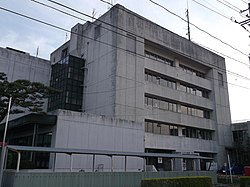Shibata, Miyagi
|
Shibata 柴田町 |
|||
|---|---|---|---|
| Town | |||

Shibata Town Office
|
|||
|
|||
 Location of Shibata in Miyagi Prefecture |
|||
| Coordinates: 38°03′23″N 140°45′57″E / 38.05639°N 140.76583°ECoordinates: 38°03′23″N 140°45′57″E / 38.05639°N 140.76583°E | |||
| Country | Japan | ||
| Region | Tōhoku | ||
| Prefecture | Miyagi | ||
| District | Shibata | ||
| Area | |||
| • Total | 54.03 km2 (20.86 sq mi) | ||
| Population (September 2015) | |||
| • Total | 39,072 | ||
| • Density | 723/km2 (1,870/sq mi) | ||
| Time zone | Japan Standard Time (UTC+9) | ||
| - Tree | Momi Fir | ||
| - Flower | Sakura | ||
| - Bird | Pheasant | ||
| Phone number | 0224-55-2111 | ||
| Address | 2-3-45 Funaoka-chuo, Shibata-machi, Shibata-gun, Miyagi-ken 989-1692 | ||
| Website | Official website | ||
Shibata (柴田町 Shibata-machi?) is a town located in Shibata District, Miyagi Prefecture, Japan. As of September 2015, the town had an estimated population of 39,072 and a population density of 723 persons per km². The total area was 54.03 square kilometres (20.86 sq mi).
Shibata is located in south-central Miyagi Prefecture. The Shiroishi River runs through the town.
The area of present-day Shibata was part of ancient Mutsu Province.The villages of Funaoka and Tsukinoki were established on April 1, 1889 with the establishment of the municipalities system. Tsukioki was promoted to town status on April 1, 1904 and Funaoki on November 3, 1941. The two towns merged to form Shibata on April 1, 1956
The economy of Shibata is largely based on agriculture.
...
Wikipedia


